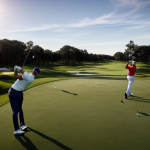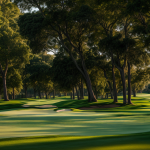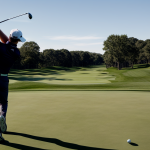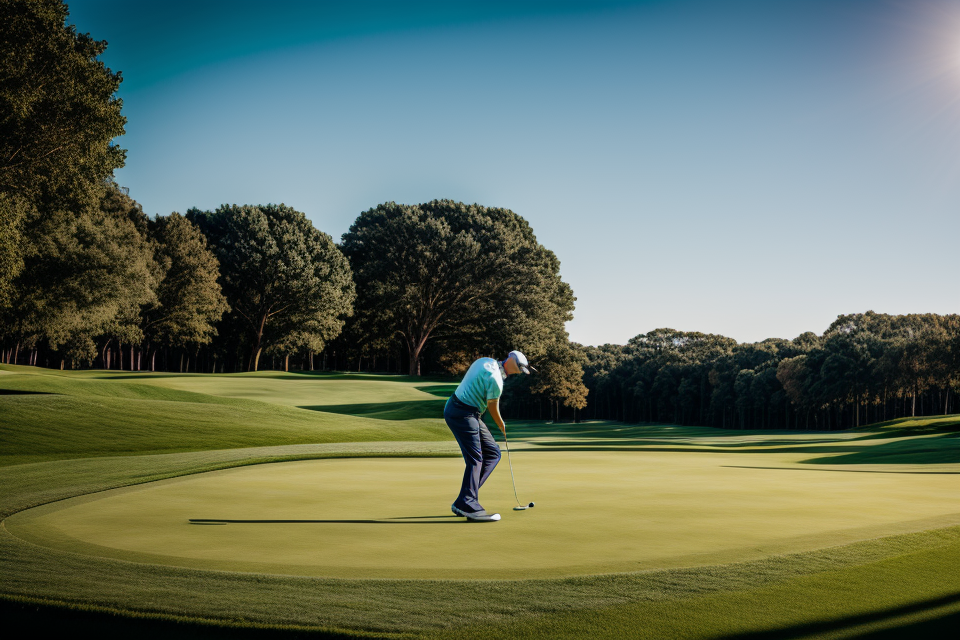Golf is a game that requires precision and skill, and choosing the right golf clubs is crucial to achieving success on the course. With so many options available, it can be overwhelming to decide which clubs are best for your game. That’s why we’ve created “The Ultimate Guide to Choosing the Right Golf Clubs for Your Game.” In this guide, we’ll take a closer look at the different types of golf clubs available, including drivers, fairway woods, hybrids, irons, and wedges. We’ll also discuss factors to consider when selecting golf clubs, such as your swing type, ball flight, and course conditions. Whether you’re a beginner or an experienced golfer, this guide will provide you with the information you need to choose the right golf clubs for your game and improve your performance on the course.
Understanding the Basics of Golf Clubs
The Anatomy of a Golf Club
The anatomy of a golf club is composed of three main parts: the grip, the shaft, and the clubhead.
Grip
The grip is the part of the golf club that the player holds in their hands. It is usually made of rubber or cord and is designed to provide a comfortable and secure hold on the club. The grip size and shape can vary depending on the player’s preference and the type of golf club.
Shaft
The shaft is the long, flexible part of the golf club that connects the grip to the clubhead. It is typically made of graphite or steel and is designed to provide both power and control to the player’s shots. The shaft length and flexibility can also vary depending on the player’s height, strength, and swing type.
Clubhead
The clubhead is the business end of the golf club, where the ball is struck. It is usually made of metal or a metal alloy and is designed to provide maximum impact and distance on the ball. The clubhead shape and size can vary depending on the type of golf club, with drivers having a larger and more rounded clubhead compared to irons and wedges.
It is important to understand the anatomy of a golf club in order to choose the right one for your game. Each part of the golf club serves a specific purpose and can affect the player’s performance on the course. By understanding the grip, shaft, and clubhead, you can make an informed decision when selecting the right golf clubs for your game.
The Different Types of Golf Clubs
Golf clubs come in various types, each designed for specific purposes and playing conditions. It is essential to understand the different types of golf clubs to make informed decisions when selecting the right ones for your game.
Woods
Woods are the longest and straightest golf clubs in the bag, typically used for tee shots and long par-4s. They have a low loft and a large sweet spot, making them ideal for hitting the ball a long distance with accuracy. The most common types of woods are the driver and the fairway wood.
Irons
Irons are used for a variety of shots, from short pitches to long approach shots. They have progressively higher lofts and smaller sweet spots than woods, making them more precise but less forgiving. Irons come in sets, usually including 3-9, with the higher numbers being more lofted and used for shorter shots.
Hybrids
Hybrids are a combination of woods and irons, designed to replace traditional long irons in the bag. They have a larger sweet spot and more forgiveness than traditional long irons, making them easier to hit. Hybrids are typically used for similar shots as long irons, such as approach shots and mid-range shots.
Wedges
Wedges are used for high-lofted shots around the green, such as chip shots, pitch shots, and bunker shots. They have the highest lofts of all clubs and the smallest sweet spots, making them extremely precise but challenging to hit. Wedges come in a variety of lofts, including sand wedges, lob wedges, and approach wedges.
Putters
Putters are used for rolling the ball onto the green and into the hole. They have the highest loft and the largest head of any club in the bag, with a flat face designed to glide the ball along the grass. Putters come in a variety of shapes and sizes, including blade putters, mallet putters, and belly putters.
Choosing the right golf clubs for your game depends on your skill level, playing style, and course conditions. It is essential to understand the different types of golf clubs and their specific uses to make informed decisions when selecting the right ones for your bag.
Assessing Your Game
Identifying Your Swing Type
One of the most important factors in choosing the right golf clubs for your game is identifying your swing type. This involves determining the angle of attack you use when hitting a golf ball, which can be categorized into three main types: steep angle of attack, neutral attack angle, and flat or shallow angle of attack.
Steep angle of attack
A steep angle of attack occurs when the clubhead moves down and toward the target in a steep, vertical motion during the swing. Golfers who use a steep angle of attack tend to have a fast swing speed and generate a lot of power. They may benefit from using golf clubs with a lower loft, such as a 7-iron or lower, to help keep the ball from rising too high.
Neutral attack angle
A neutral attack angle is characterized by a relatively straight movement of the clubhead during the swing, with no excessive tilting or twisting. Golfers with a neutral attack angle can use a variety of golf clubs, but may benefit from those with a medium loft, such as a 5-iron or 6-iron.
Flat or shallow angle of attack
A flat or shallow angle of attack occurs when the clubhead moves down and away from the target in a shallow, horizontal motion during the swing. Golfers who use a flat or shallow angle of attack tend to have a slower swing speed and may struggle to get the ball airborne. They may benefit from using golf clubs with a higher loft, such as a sand wedge or lob wedge, to help the ball get off the ground.
By identifying your swing type and understanding how it affects your game, you can make informed decisions when choosing the right golf clubs for your needs.
Determining Your Ball Flight
When it comes to choosing the right golf clubs for your game, understanding your ball flight is a crucial factor to consider. Here are some details to help you determine your ball flight:
High Ball Flight
A high ball flight occurs when the ball travels a long distance in the air before starting its descent. If you hit a high ball flight, it means that your golf ball is traveling too high and not carrying enough distance. This could be due to a lack of clubhead speed or an improper ball position. To lower your ball flight, you may want to try using a lower lofted driver or adjusting your ball position to the back of your stance.
Low Ball Flight
On the other hand, a low ball flight occurs when the ball doesn’t travel very far in the air before landing. If you hit a low ball flight, it may mean that your golf ball is not spinning enough or that you are hitting the ball too high on the clubface. To increase your ball flight, you can try using a higher lofted driver or adjusting your ball position to the middle of your stance.
Straight Ball Flight
A straight ball flight is when the ball travels in a straight line, neither too high nor too low. If you hit a straight ball flight, it means that you are hitting the ball with the right amount of clubhead speed and ball position. However, if you want to adjust your ball flight, you can try using a different lofted driver or adjusting your ball position slightly.
By understanding your ball flight, you can make informed decisions when choosing the right golf clubs for your game. It’s important to remember that each golfer is unique, and what works for one person may not work for another. Experiment with different clubs and techniques to find what works best for you.
Identifying Your Misses
Slice
A slice is a shot that curves from right to left for right-handed golfers and from left to right for left-handed golfers. Identifying a slice can be helpful in determining the appropriate golf club for your game. A slice is typically caused by an inward spin on the ball, which can be the result of a closed clubface at impact. To correct a slice, you may need to use a more lofted driver or fairway wood to help the ball rise and reduce the spin.
Hook
A hook is a shot that curves from left to right for right-handed golfers and from right to left for left-handed golfers. Identifying a hook can also help you choose the right golf club for your game. A hook is typically caused by an outward spin on the ball, which can be the result of an open clubface at impact. To correct a hook, you may need to use a less lofted driver or fairway wood to help the ball fly lower and reduce the spin.
Fat shot
A fat shot is a shot that travels a short distance and tends to go straight down instead of forward. Identifying a fat shot can help you determine the appropriate golf club for your game. A fat shot can be caused by a number of factors, including poor alignment, a weak grip, or a poor swing. To correct a fat shot, you may need to use a club with more loft or a club with a lower trajectory to help the ball get airborne and travel further.
Thin shot
A thin shot is a shot that lacks depth and barely makes contact with the ball. Identifying a thin shot can also help you choose the right golf club for your game. A thin shot can be caused by a number of factors, including a weak swing, a closed clubface, or a poor impact position. To correct a thin shot, you may need to use a club with more loft or a club with a lower trajectory to help the ball get airborne and travel further. Additionally, you may need to focus on improving your impact position and making solid contact with the ball.
Choosing the Right Clubs for Your Game
Woods
Woods are an essential part of any golfer’s bag, and choosing the right ones can greatly improve your game. Here are some factors to consider when selecting your woods:
- Loft: The loft of a wood determines the height and distance of your shots. A higher loft will result in a higher, shorter shot, while a lower loft will produce a longer, lower shot.
- Forgiveness: Forgiveness refers to how well the club performs on off-center hits. Some woods are more forgiving than others, meaning they will perform better if you don’t hit the ball directly in the center of the clubface.
- Accuracy: Some woods are designed to provide more accuracy, especially on shorter shots. These clubs are typically more compact and have a lower profile, making them easier to control.
- Flexibility: Some woods are designed to be more versatile, offering a range of shot options. These clubs may have adjustable weights or adjustable lofts, allowing you to customize your shot for different situations.
- Shaft Material: The shaft material can also affect the performance of your woods. Graphite shafts are lighter and offer more flexibility, while steel shafts are heavier and provide more stability.
When choosing your woods, it’s important to consider your skill level, swing speed, and the types of shots you need to hit. A professional golfer may require different woods than a beginner, and a player with a slower swing speed may benefit from more forgiving woods.
Irons
Irons are a type of golf club that are used to hit the ball a relatively long distance with a high degree of accuracy. They are typically made of steel or graphite and have a solid head that is designed to hit the ball with a low, glancing blow. Irons are available in a range of loft angles, which determines the height and distance of the shot.
Long Irons
Long irons are typically numbered 1 through 5 and are used for hitting the ball long distances. They have a lower loft angle than other irons, which allows the ball to travel further and straighter. Long irons are best suited for players who have a high ball speed and want to hit the ball a long way.
Mid Irons
Mid irons are typically numbered 6 through 9 and are used for hitting shots that are both long and accurate. They have a higher loft angle than long irons, which allows the ball to travel further while also staying in the air longer. Mid irons are best suited for players who want to hit the ball a moderate distance with good accuracy.
Short Irons
Short irons are typically numbered 10 through pitching wedge and are used for hitting shots that are very short distances, such as from the fairway or from around the green. They have a very high loft angle, which allows the ball to travel a short distance and land softly on the green. Short irons are best suited for players who want to hit precise shots with a lot of control.
Hybrids
Hybrids are a type of golf club that combines the benefits of woods and irons. They are designed to replace traditional long irons in a golfer’s bag and provide more forgiveness and ease of use.
Here are some key factors to consider when choosing hybrids:
- Loft: Hybrids typically have a higher loft than irons, which makes them easier to hit and provides more control over the ball’s trajectory.
- Shaft: Hybrids typically have a lighter shaft than woods, which makes them easier to swing and provides more control over the ball’s trajectory.
- Head size: Hybrids typically have a larger head size than irons, which provides more forgiveness on off-center hits.
- Offset: Hybrids typically have an offset hosel, which moves the center of gravity closer to the golfer’s body and provides more forgiveness on off-center hits.
Overall, hybrids are a great option for golfers who want to improve their accuracy and forgiveness on long shots, while still maintaining some of the distance and power benefits of woods.
Wedges
When it comes to choosing the right golf clubs for your game, wedges are an essential category to consider. Wedges are designed to help golfers hit high, short shots with precision and control, making them perfect for approach shots, chip shots, and sand shots. Here are the three main types of wedges to consider:
- Gap wedges: Gap wedges are designed to fill the gap between your iron sets and help you hit shots from various distances. They typically have a lower loft than your standard irons and are designed to be more forgiving, making them ideal for players who struggle with long irons.
- Sand wedges: Sand wedges are designed specifically for hitting shots out of bunkers. They have a higher loft than gap wedges and are designed to help golfers get the ball out of sand traps with ease.
- Lob wedges: Lob wedges are designed for high, soft shots around the green. They have the highest loft of all wedges and are typically used for shots that need to be hit high and land softly, such as lob shots over hazards or bunkers.
When choosing wedges, it’s important to consider your swing type and the types of shots you struggle with. For example, if you struggle with long irons, a gap wedge may be the perfect choice for you. If you struggle with shots around the green, a lob wedge may be the way to go. It’s also important to consider the condition of the courses you play and the types of shots you’ll need to hit. For example, if you play a lot of courses with bunkers, a sand wedge may be a must-have.
Ultimately, the right wedges for your game will depend on your skill level, swing type, and the types of shots you struggle with. By taking the time to choose the right wedges, you can improve your accuracy and shot-making ability, making your game more enjoyable and successful.
Putters
When it comes to choosing the right putter for your game, there are a few key factors to consider.
Mallet Putters
Mallet putters are a popular choice for many golfers due to their large, flat surfaces and high MOI (moment of inertia), which makes them more forgiving on off-center hits. They are typically made of lightweight materials like aluminum or graphite and have a larger sweet spot for improved accuracy. Mallet putters are a good choice for golfers with a slower tempo or those who struggle with keeping the putter head square at impact.
Blade Putters
Blade putters, on the other hand, have a more traditional design with a smaller head and a lower MOI. They are typically made of steel and have a more precise feel at impact. Blade putters are a good choice for golfers with a faster tempo and a more consistent putting stroke. They require a higher degree of skill to use effectively, so they may not be the best choice for beginner golfers.
Putter Length and Weight
In addition to the type of putter you choose, it’s also important to consider the length and weight of the club. A putter that is too short may be difficult to control, while a putter that is too long may be difficult to square the clubhead at impact. Most putters range in length from 32 to 36 inches, and the ideal length will depend on your height and arm length.
When it comes to weight, a heavier putter can help with the feel and stability at impact, but it can also make it more difficult to control the clubhead. A lighter putter may be easier to control, but it may also feel less stable at impact.
In conclusion, choosing the right putter for your game requires considering factors such as the type of putter, length, and weight. By taking these factors into account, you can find a putter that fits your game and helps you improve your putting skills.
Evaluating Your Equipment
Clubhead speed
When it comes to choosing the right golf clubs for your game, one of the most important factors to consider is your clubhead speed. This refers to the speed at which you swing your golf club, and it can have a significant impact on the distance and accuracy of your shots.
In general, clubhead speed can be classified into three categories: slow, moderate, and fast. Understanding your own clubhead speed is crucial in determining the right golf clubs for your game.
Slow Clubhead Speed
If you have a slow clubhead speed, it means that you swing your golf club at a slower pace than most golfers. This can be due to a variety of factors, such as lack of strength or flexibility, or a technical flaw in your swing.
If you have a slow clubhead speed, it’s important to choose golf clubs that are designed to help you generate more speed and power. This might include using heavier clubs or shafts, or choosing clubs with a larger sweet spot.
Moderate Clubhead Speed
If you have a moderate clubhead speed, you likely fall within the average range for golfers. This means that you have a good amount of power and control in your swings, but you may still benefit from using clubs that are tailored to your specific needs.
When choosing golf clubs with a moderate clubhead speed, it’s important to consider factors such as ball speed, spin rate, and trajectory. You’ll want to choose clubs that help you achieve the right balance of distance and accuracy, without sacrificing one for the other.
Fast Clubhead Speed
If you have a fast clubhead speed, it means that you swing your golf club at a faster pace than most golfers. This can be due to factors such as strength, speed, and a technical flaw in your swing.
If you have a fast clubhead speed, it’s important to choose golf clubs that are designed to help you maintain control and accuracy, even with your powerful swings. This might include using lighter clubs or shafts, or choosing clubs with a smaller sweet spot.
Ultimately, the key to choosing the right golf clubs for your game is to understand your own strengths and weaknesses, and to choose clubs that help you maximize your potential on the course. By considering factors such as clubhead speed, ball speed, spin rate, and trajectory, you can find the perfect set of golf clubs to help you improve your game and achieve your goals on the course.
Launch angle
When it comes to choosing the right golf clubs for your game, one of the most important factors to consider is your launch angle. Your launch angle refers to the angle at which your golf ball leaves the clubface during the swing.
There are three main categories of launch angle: low, moderate, and high. Understanding these categories can help you determine the best golf clubs for your game.
- Low launch angle: A low launch angle is typically associated with a lower ball flight, which can be beneficial for players who tend to slice the ball. Golfers with a low launch angle typically have a slower swing speed and may benefit from using clubs with a lower loft, such as a 3 wood or a 5 iron.
- Moderate launch angle: A moderate launch angle is ideal for most golfers, as it provides a balanced ball flight that is neither too high nor too low. This launch angle is typically achieved with a driver or a fairway wood with a moderate loft, such as a 3 wood or a 5 wood.
- High launch angle: A high launch angle is associated with a higher ball flight, which can be beneficial for players who tend to hook the ball. Golfers with a high launch angle typically have a faster swing speed and may benefit from using clubs with a higher loft, such as a driver or a 3 wood with a higher loft.
In conclusion, the launch angle of your golf shot is an important factor to consider when choosing the right golf clubs for your game. Understanding the different categories of launch angle can help you determine the best clubs for your swing type and playing style.
Ball spin rate
When evaluating your equipment, one important factor to consider is the ball spin rate. The ball spin rate refers to the amount of backspin that is imparted on the golf ball during impact with the clubface. This can have a significant impact on the trajectory, control, and roll of the ball.
There are three main categories of ball spin rate: low, moderate, and high. Understanding the characteristics of each can help you choose the right golf clubs for your game.
Low Ball Spin Rate
A low ball spin rate is typically associated with a higher launch angle and a lower ball flight. This can be beneficial for players who struggle with slice or hook shots, as it can help keep the ball more stable in the air. Golfers with a low ball spin rate may benefit from using drivers with a higher loft and lower spin, such as a 3-wood or 5-wood.
Moderate Ball Spin Rate
A moderate ball spin rate is ideal for most golfers, as it provides a balance between distance and control. This spin rate allows the ball to achieve a higher peak height and a steeper descent angle, resulting in a more stable and predictable ball flight. Golfers with a moderate ball spin rate may benefit from using a variety of clubs, including drivers, fairway woods, and hybrids, with a moderate loft and spin.
High Ball Spin Rate
A high ball spin rate is typically associated with a lower launch angle and a lower ball flight. This can be beneficial for players who struggle with hook or slice shots, as it can help keep the ball more stable in the air. Golfers with a high ball spin rate may benefit from using drivers with a lower loft and higher spin, such as a 9.5-degree driver. Additionally, they may benefit from using lower-lofted irons, such as a 2-iron or 3-iron, which can help reduce spin and promote a straighter ball flight.
Overall, it’s important to understand your ball spin rate and how it affects your shot-making ability. By evaluating your equipment and selecting clubs that complement your ball spin rate, you can improve your overall game and achieve more consistent results on the golf course.
Swing weight
When it comes to choosing the right golf clubs for your game, one of the most important factors to consider is swing weight. Swing weight refers to the balance and weight distribution of the golf club, which can have a significant impact on your swing and overall performance. Here’s a closer look at the three main types of swing weight:
- Light swing weight
- Standard swing weight
- Heavy swing weight
Light Swing Weight
A light swing weight golf club is typically lighter in weight and has a higher balance point, making it easier to swing and more suitable for players with slower swing speeds or those who struggle with maintaining control during their swing. These clubs are often preferred by female golfers, senior golfers, or anyone who is new to the game and still developing their swing.
Standard Swing Weight
A standard swing weight golf club is generally well-balanced and has a moderate weight, making it suitable for a wide range of players with different skill levels. This type of club is designed to provide a good balance of control and power, making it a popular choice for many golfers.
Heavy Swing Weight
A heavy swing weight golf club is typically heavier in weight and has a lower balance point, making it more difficult to swing but also providing more control and stability for players with faster swing speeds or those who want to add more power to their shots. These clubs are often preferred by more experienced golfers or those who want to add distance to their drives.
It’s important to note that the right swing weight for you will depend on your individual swing characteristics, such as your swing speed, swing plane, and overall physical strength. A professional club fitter can help you determine the best swing weight for your game by analyzing your swing and providing personalized recommendations based on your specific needs.
FAQs
1. What factors should I consider when choosing golf clubs?
When choosing golf clubs, it’s important to consider several factors such as your skill level, swing speed, ball flight, and playing conditions. For example, if you are a beginner, you may want to choose clubs that are easier to use and have a more forgiving sweet spot. On the other hand, if you are an advanced player, you may want to choose clubs that offer more control and precision.
2. How do I know what golf club to use for different shots?
To determine what golf club to use for different shots, you should consider the distance you need to hit the ball and the type of shot you want to make. For example, if you need to hit a long shot, you may want to use a fairway wood or a hybrid. If you need to hit a short shot around the green, you may want to use a wedge or a putter.
3. How often should I replace my golf clubs?
The frequency with which you should replace your golf clubs depends on several factors such as your skill level, playing conditions, and the condition of your clubs. As a general rule, if your clubs are more than 10 years old or show significant wear and tear, it may be time to replace them. Additionally, if you have improved your swing or your playing conditions have changed, you may benefit from upgrading to newer clubs.
4. How do I know what golf club to use for my driver?
To determine what golf club to use for your driver, you should consider your swing speed and ball flight. If you have a slower swing speed, you may want to choose a driver with a larger head and a lower loft. If you have a faster swing speed, you may want to choose a driver with a smaller head and a higher loft. Additionally, if you tend to slice the ball, you may want to choose a driver with a more closed face.
5. Can I use the same golf clubs for all courses?
While it’s possible to use the same golf clubs for all courses, it’s important to consider the playing conditions at each course. For example, if you’re playing a course with dense rough or a lot of water hazards, you may want to choose clubs that offer more control and precision. Additionally, if you’re playing a course with narrow fairways, you may want to choose clubs that offer more forgiveness.









